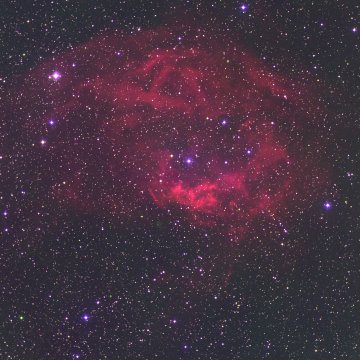Sh 2-261
Coordinates: (194.1°, -1.9°)
[ Catalog | Explorer | SIMBAD ]
The Lowers were amateur astronomers, accomplished telescope makers and pioneering astrophotographers from San Diego, California. Harold Lower published a pamphlet in 1939 describing an 8 inch Schmidt camera that he and his son had constructed several years previously. He notes that the camera has been especially useful in photographing what are now called HII regions:
Another field which we have found interesting is searching for diffuse galactic nebulae which photograph strongly by red light. By the use of red-sensitive film and a deep red filter we have been able to photograph a number of nebulae which are exceedingly faint on blue-sensitive negatives. [1]
Appears to be associated with the O7.5V star HD 41997.[2]
HD 41997 is a runaway star.[3]
BFS incorrectly lists Sh 2-261 as a supernova remnant. [4]
There are several distance estimates available for Sh 2-261 / HD 41997. If the further distances are correct, Sh 2-261 is likely part of the Gemini molecular clouds in the Perseus arm. If the closer 1000 pc distance is correct, then it appears to be part of the Orion spur.
Notes
1. ^ Lower, H. A. (1939). "The Schmidt Camera", Leaflet of the Astronomical Society of the Pacific, Vol. 3, 207. [1939ASPL....3..207L]
2. ^ Sharpless, Stewart (1959). "A Catalogue of H II Regions.", The Astrophysical Journal Supplement Series, Vol. 4, 257. [1959ApJS....4..257S]
3. ^ Moffat, A. F. J., Marchenko, S. V., Seggewiss, W., et al. (1998). "Wolf-Rayet stars and O-star runaways with HIPPARCOS. I. Kinematics", Astronomy and Astrophysics, Vol. 331, 949-958. [1998A&A...331..949M]
4. ^ Blitz, L., Fich, M., & Stark, A. A. (1982). "Catalog of CO radial velocities toward galactic H II regions", The Astrophysical Journal Supplement Series, Vol. 49, 183-206. [1982ApJS...49..183B]
Distance estimates
1000 pc [1987A&A...171..216C]1800 pc [1995ApJ...445..246C]
2420 pc +/- 584 [2009A&A...507..833M]
Links
[ DSS | ADS | ADS Abstract ]
map | book | blog | gallery | sources

This image was created using the POSS-II/UKSTU data of the Digitized Sky Survey and SuperCOSMOS using the process described here.
According to my correspondence with the Royal Observatory Edinburgh and the Space Telescope Science Institute, I am allowed to use the POSS-II/UKSTU data to create and display images for non-commercial purposes so long as I include this fine print for the SuperCOSMOS data:
Use of these images is courtesy of the UK Schmidt Telescope (copyright in which is owned by the Particle Physics and Astronomy Research Council of the UK and the Anglo-Australian Telescope Board) and the Southern Sky Survey as created by the SuperCOSMOS measuring machine and are reproduced here with permission from the Royal Observatory Edinburgh.
and this acknowledgement taken from the DSS site:
The Digitized Sky Surveys were produced at the Space Telescope Science Institute under U.S. Government grant NAG W-2166. The images of these surveys are based on photographic data obtained using the Oschin Schmidt Telescope on Palomar Mountain and the UK Schmidt Telescope. The plates were processed into the present compressed digital form with the permission of these institutions.
The Second Palomar Observatory Sky Survey (POSS-II) was made by the California Institute of Technology with funds from the National Science Foundation, the National Geographic Society, the Sloan Foundation, the Samuel Oschin Foundation, and the Eastman Kodak Corporation.
The UK Schmidt Telescope was operated by the Royal Observatory Edinburgh, with funding from the UK Science and Engineering Research Council (later the UK Particle Physics and Astronomy Research Council), until 1988 June, and thereafter by the Anglo-Australian Observatory. The blue plates of the southern Sky Atlas and its Equatorial Extension (together known as the SERC-J), as well as the Equatorial Red (ER), and the Second Epoch [red] Survey (SES) were all taken with the UK Schmidt.
The "Second Epoch Survey" of the southern sky was made by the Anglo-Australian Observatory (AAO) with the UK Schmidt Telescope. Plates from this survey have been digitized and compressed by the ST ScI. The digitized images are copyright ? 1993-5 by the Anglo-Australian Observatory Board, and are distributed herein by agreement.
The "Equatorial Red Atlas" of the southern sky was made with the UK Schmidt Telescope. Plates from this survey have been digitized and compressed by the ST ScI. The digitized images are copyright ? 1992-5, jointly by the UK SERC/PPARC (Particle Physics and Astronomy Research Council, formerly Science and Engineering Research Council) and the Anglo-Australian Telescope Board, and are distributed herein by agreement.
The compressed files of the "Palomar Observatory - Space Telescope Science Institute Digital Sky Survey" of the northern sky, based on scans of the Second Palomar Sky Survey are copyright ? 1993-1995 by the California Institute of Technology and are distributed herein by agreement. The compressed files of the "Palomar Observatory - Space Telescope Science Institute Digital Sky Survey" of the northern sky, based on scans of the Second Palomar Sky Survey are copyright ? 1993-1995 by the California Institute of Technology and are distributed herein by agreement.